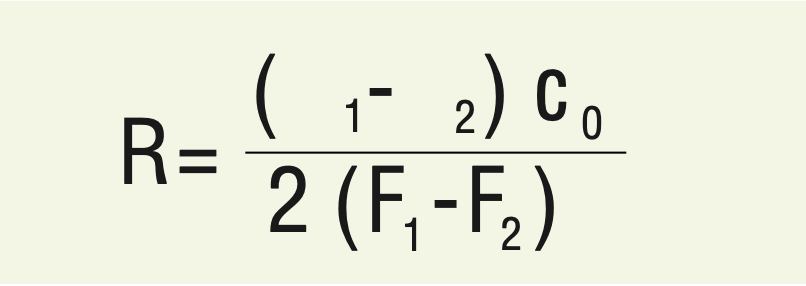Radar technology for distance detection –
Determine objects’ distances using electromagnetic waves.
As a radio-based positioning method, radar technology enables distances to be determined, among other things. It measures the distance between the radar antenna and the target object. Radar distance measurement is used in many different applications. But other sensor technologies can also reliably measure distances. Radar technology offers users advantages over other measuring methods due to its insensitivity to weather or light conditions. It also works reliably in extreme environments, where heat, cold, noise, or pollution push other technologies to their limits. Radar also provides further information that helps to precisely position objects. For example, the technology is usually used for more complex measuring tasks, such as collision protection.
How radar systems measure distances
To find out how far an object is from the radar antenna, the system must exhibit certain technical characteristics and perform calculations.
For this purpose, radar units transmit short pulses consisting of electromagnetic waves to scan the coverage area for objects. They are focused in a specific direction according to the directivity of the antenna. If the transmission pulse hits an object while spreading out, part of the signal energy is reflected back to the radar. Through the change to the pulse, different information about the object can then be derived and calculated.
The distance of an object is determined through the time required from when the transmission pulse start to when the response signal is received (transit time) and speed at which the radar waves are propagated. How fast the pulse moves through open space is a known and constant variable – the speed of light.
A simple way to calculate the distance from antenna to an object is: the distance R is obtained by finding the product of the speed of light C0 multiplied by the measured transit time t divided by the number 2 (path travelled to destination and back again). This formula is particularly well-suited for pulse radars, which systematically transmit individual pulses and wait for the echo. However, distances can also be measured by means of frequency modulation, as is common in industrial and automotive applications.
In practice, radar systems have to take into account many environmental factors as well as certain physical effects when determining distances. If these factors, such as the Doppler effect, are known, they are incorporated into the calculation in order to obtain a clean result that is as accurate as possible.
Determining distances through frequency modulation
In order to determine information about an object to be detected, it must be possible to establish a connection between the signals being sent and received. This means that the radar system can also associate the transmitted pulse with the corresponding reflection, i.e. the received response pulse. With continuous-wave radars, which continuously transmit signals, this can only be achieved with modulation.
For this purpose, the transmission signal is must be varied in a systematic manner. To achieve this, it is possible to modulate either the amplitude – the difference in the extreme values of an oscillation – (AM), the phase (PM), or the frequency (FM).
Frequency modulation has become the preferred option on the market, since it is better suited for applications and less susceptible to interference. In order to modulate the frequency, the radar developers utilise a voltage-controlled oscillator (VCO).
This method causes the frequency of the reception signal to shift and stand apart from the transmission signal over the transit time. With linear frequency modulation, this offset is proportional to the distance and the transit time of the wave and can therefore be calculated. (For the calculation, see FMCW radar).
Which radars are well-suited for measuring distances?
Continuous-wave radars can be divided up based on the modulation method used: unmodulated CW (continuous-wave) radar, FSK (frequency shift keying) radar, and modulated FMCW (frequency-modulated continuous wave) radar.
The CW method does not employ modulation. It is thus impossible to measure distances. However, CW radars detect the presence, speed, and direction of movement of moving objects and are therefore often used for recording speeds in traffic.
The FSK method does not change its frequency continuously but instead jumps back and forth between two values. FSK radar compares the phases between the two states to determine an object’s distance. The modulation method is suitable only for measuring the distances of moving objects. This can prove advantageous depending on the application.
The FMCW method usually uses triangular or sawtooth frequency modulation. It allows the distances of stationary and moving objects to be measured. At the same time, their speed can be detected. With the right antenna concept, FMCW radars can also determine the angular position of the objects. The distance is calculated taking into account the frequency bandwidth and the measured difference in frequency (deviation).
The distance can be calculated with linear frequency-modulated radar units using the following formula:
The distance resolution
If a radar system is supposed to detect multiple objects and identify them as individual targets, the resolution comes into play. This defines how well a radar unit can distinguish individual objects that are next to each other or one behind another and based on which parameters.
The distance resolution of a radar depends on the frequency bandwidth used (frequency deviation). It is calculated from the speed at which radar waves are propagated and the available bandwidth: ΔR=c0/(2 Δf)
With the selection of a particular frequency band, the available bandwidth and wave frequency (propagation) are already defined. The frequencies used for radar applications is strictly regulated. Find out more in our blog.
In order to reliably distinguish two objects that are located directly next to each other, the radar units utilise additional measurement information such as speed or angular position. Find out more in our blog article about radar resolution.
Precise distance measurement
How precisely the distance can be calculated is determined by the measurement accuracy. It indicates the size of the smallest measurable distance increment for detecting distances. In practice, this would mean, for instance, to exactly how many millimetres the distance of an object can be measured.
Besides the bandwidth, the accuracy also depends on the signal quality (signal-to-noise ratio) and the measuring time. Find out more here.
The measurement accuracy also depends on the distance. The greater the distance, the less accurate the result. In order to ensure valid measurement data is obtained, radar developers optimise the measuring time and signal quality, for instance, and integrate various filters in the signal processing.
In addition, the specification of reference points for calibration (subsequently via software) can have a positive impact on the measurement accuracy for high-precision measurements.
Other factors influencing distance detection
The antenna design and the directivity of the radar beam play a crucial role in determining the detection range. If the radar unit’s sole purpose is to conduct high-precision distance measurements, it is recommended to strongly focus the wave propagation using a narrow beam with high accuracy and resolution.
The radar’s sensitivity also impacts distance measurement. The more sensitive the system, the more easily objects with a small radar cross section (RCS) can be detected. They are harder to detect at longer distances from the radar due to the very weak response signal.
Digital FMCW radars present a further challenge with regard to distance measurement. They may result in ambiguous returns and overreach due to the sampling theorem. The information received can then no longer be clearly assigned to a specific target. This can be circumvented only through additional modulation work. This leads to additional necessary calculations to correct the distance measurement.
In practice, many environmental aspects also play a role, which can make distance detection more difficult. The radar unit also detects multiple reflections and non-linear effects (for example, strong reflections can cause ghost targets). These must be identified and eliminated by means of tracking algorithms.
Other interfering factors stem, for example, from the weather or situation: rain, wind movements, and animals can also present distractions when the distance of a specific target is being measured. With clever filter functions and signal processing, it is possible to clean the measurement results and configure the radar systems to fit the application. Through such features, modern and advanced radar units for distance measurement are considered to be extremely robust, reliable, and precise.
Advantages of distance measurement via radar
Many sensor technologies are tried and tested in measuring distances. Radar puts its advantages on full display in difficult measuring environments. The technology is increasingly being used for fill level measurement. Such use cases often entail extreme temperatures, dirt, noise, foaming, vapour, or dust, and many of these factors make signal analysis more difficult for measurement systems.
Another advantage of radar technology is that it can capture a range of object information (presence, distance, speed, angle, signal amplitude). The more object data available, the more targeted of a measurement can be performed. This makes enables only certain objects to be focused on during measurement. For example, radar might be used to detect only targets with a certain speed or RCS.
In addition, the detection range can be optimally adapted to the subsequent application: wide-ranging detection of the surroundings is required for collision protection. For fill level measurement, usually narrow areas in a silo are supposed to be scanned.
However, distance information can also prove crucial in other industries, such as security technology. In this area, among other things, users can adjust the range of a sensor in order to ignore irrelevant targets outside their own property when detecting motion. Read more here.
A step ahead
In recent years, radar development has made innovative progress in terms of distance measurement using radar technology. Not only can the current distance and position of an object be calculated, but also the next expected coordinate. This enables the coming distance and position of a target to be predicted. For this purpose, the radar system monitors an object over a long period of time (radar tracking) and uses the object’s inertia to make predictions. According to this rule, an object first stops before changing direction and does not suddenly jump anywhere. The software’s signal processing then utilises special mathematical algorithms to determine the most probable next distance point based on the object’s movement history.
InnoSenT has already been developing radar systems for distance measurement for many years. Products such as the iSYS-6030 radar system are used for applications such as fill level detection or collision protection. But in the automotive sector as well, distance information fulfils an important function for driver assistance systems. In addition, it is essential for multi-functional systems in the field of security systems in order to position targets. You can find further information here.
Header Picture Source: © anttoniart by adobestock.com
Share this Content
Get this technology on your radar
Information on this advanced sensor technology
The demand for sensors is increasing due to trends such as digitalisation, automation in industry & logistics, smart homes & cities, and autonomous driving. But the development and integration of radar units is a complex topic, and the technical terms and functions raise many questions for users. Our radar experts have put together comprehensive information to help you get started in the world of radar.




